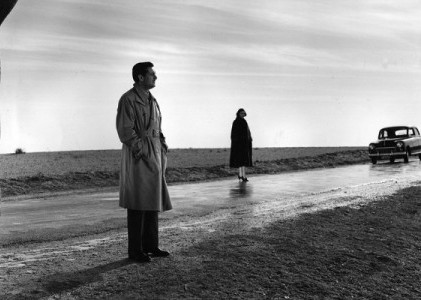World Weary
This article is published in conjunction with Noir City, the 12th edition of the annual San Francisco film noir festival founded by Eddie Muller. The festival runs from January 24 through February 2, 2014.
It's a small world when you try to escape, a big world when you want to get
home. This is a lesson learned by exiles and fugitives; and a lesson of film
noir is that everyone, in some sense, is an exile and a fugitive. As the
Algerian-born French colonial Albert Camus wrote, “In a universe suddenly
divested of illusions and lights, man feels an alien, a stranger. His exile is
without remedy since he is deprived of the memory of a lost home or the hope of
a promised land.”
Such is the fate of the title character in Pépé
le Moko (1937), a French gangster on the lam who lives like a king in the
native quarter of Algiers.
He has everything except freedom, and in the end he succumbs not to the law but
to his own suicidal blend of yearning, fatalism, and defiance. Pining for Paris, he tells a
glamorous woman veiled in perfume and diamonds that she reminds him of riding
the Metro. He would understand why another Frenchman (Yves Montand), stranded
in a squalid South American backwater in Wages
of Fear (1953), cherishes a single Paris
metro ticket. Wages of Fear is about
men so desperate to escape the place they’re stuck in that they will risk their
lives for the chance of a pay-off big enough to set them free. All the
bullet-sweating suspense of their explosives-laden trucks grinding over bad
mountain roads is driven by that metro ticket and the dream it flimsily
embodies.
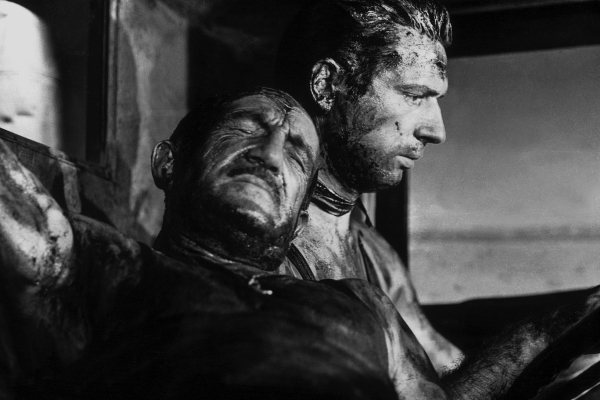
Wages of Fear
Eventually, some exiles realize that it doesn’t matter where they are. “I’ve
been lonely in Times Square on New Year’s
Eve,” an American fugitive adrift in the Far East
confesses in Macao (1952). This line sounds like the
work of Nicholas “I’m a Stranger Here Myself” Ray and star Robert Mitchum, who
patched the film together after Josef von Sternberg was fired—not before he
applied his patented smoky luster to this deliciously insubstantial movie.
“It’s a bitter little world,” is the tag line of this year’s Noir City
festival, which will run at San
Francisco’s magnificent Castro Theater January
24-February 2. This twelfth iteration of the annual festival, presented by the
Film Noir Foundation and hosted by FNF founder Eddie Muller, will for the first
time offer a global tour of noir, from the louche Paris underworld of Rififi to the jostling, sun-struck
Buenos Aires of Hardly a Criminal;
from the lurid oriental decadence of Sternberg’s Shanghai Gesture to the bleak southwest deserts of Border Incident. The lineup ranges from
the familiar and beloved (The Third Man)
to the rare and little-known (the Norwegian Death
is a Caress), from Hollywood’s
glossy studio-bound visions of the exotic to authentic foreign locations and
raw exposures of war’s unhealed wounds.
Film noir owes much to expatriates; it flourished in a war-ravaged era that
displaced many people and left even more estranged and disoriented as their
cities and nations changed around them. As Hollywood took in refugees from
Nazi-dominated Europe, it also absorbed and
adapted elements of German
expressionism, French poetic realism, and Italian neorealism. After the war,
foreign cinema re-absorbed the influence by imitating popular American crime
thrillers. The spread of noir could be viewed as an expression of the postwar
Americanization of the world (as it was, darkly, by British critics). But every
country inflected noir with its own accent and climate, its particular
anxieties and fears.
In American noir films, people undo themselves by overreaching: grabbing
at that big chance they are sure will bring them success and happiness, they
fall into a nightmare of punishment. (Such is the premise of Too Late for Tears [1949], a long-thought-to-be-lost
gem that has been painstakingly restored by the Film Noir Foundation and will
premiere at Noir City on January 25.) Other cultures lack this fatal optimism.
The petty criminals of British noir scrabble after much smaller stakes (in It Always Rains on Sunday, three hapless
crooks try to peddle a load of stolen roller skates) and console themselves
with acerbic flippancy. In Japanese noir, money often matters less than honor
and social duty: guilt and obligation are the sharpest goads. And in French
films, people often succumb to a kind of terminal melancholy, a nihilistic
exhaustion with life.
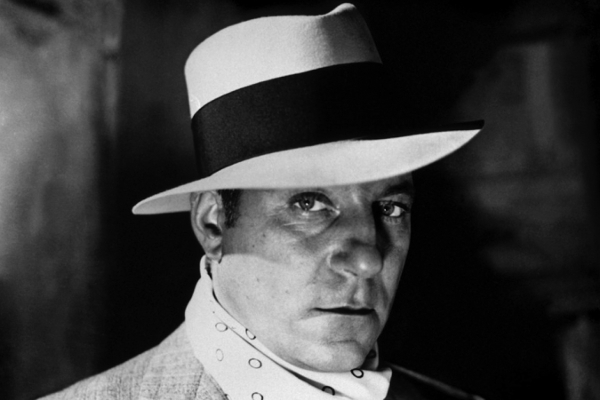
Pepe Le Moko
I. Exile without Remedy: Varieties of Alienation
Julien Duvivier’s Pépé le Moko is
the earliest film in the series and only pre-War entry. It represents the
French style of poetic realism, which combined lyrically bleak stories, seedy
settings, and moody atmosphere to produce a string of cinematic masterpieces in
the late 1930s, filled with fatalistic premonitions of France’s
wartime defeat. The definitive poetic realist anti-hero was Jean Gabin,
arguably the first global icon of noir, who dominated pre-War French cinema
with his proletarian skepticism, unadorned simplicity, and magnetically
forceful attention. Both everyman and outsider, both tender and violent, he was
above all honest, with an unsurpassed ability to confront us with the reality
of his existence. At the heart of Gabin’s poetic realist films was what André
Bazin called his “enraged outcry against the universe, ” an inevitable moment
when he lashes out in anger and disgust at the corruption of his fellow men and
the general rottenness of life. No one else could face death and defeat so
consistently yet leave such an overwhelming impression of strength.
Pépé le Moko was Gabin’s Casablanca,
the breakthrough film that made him an international star, and the most
shamelessly romantic version of his persona. The film is richly entertaining,
set in a flamboyantly stylized, pungently atmospheric recreation of the Casbah
filled with heat and noise, twisting alleys and crowded market stalls; gypsies,
beggars, Arab spies, and slumming tourists. Pépé is a dapper, cocky
charmer—Gabin even brushes off his song-and-dance chops for a musical
number—but a reckless despair lurks under his easy confidence. It’s triggered
when he meets an alluring Parisian courtesan (Mireille Balin), with whom he
sparks in a luminous exchange of close-ups and bonds through a rhapsodic
recitation of Paris
streets and landmarks. Increasingly thwarted and hemmed in, he descends into
drunken rage at his imprisonment. “I’m a free man!” he cries, taking off on a
blind dash through the maze of winding alleys. But in the end, he can only
assert his freedom by destroying himself.
“It’s like a weariness you can’t fight against. Living is hard.” This sums up
the essence of Une si Jolie Petite Plage (Riptide, 1949), perhaps the purest
demonstration of the Gallic ability to make despair attractive. The film
consists of little besides a young man in a trench coat wandering mournfully
around a bleak seaside town in ceaseless winter rain. The spell this casts
depends largely on the fragile, angelic beauty of Gérard Philipe, who plays
this lost boy, Pierre; it breaks your heart just to look at him. There is a
muted back-story that gradually reveals Pierre’s
miserable youth as an orphan, the devil’s bargain he made with an older woman,
and how he ultimately broke it. He seems to care less about escaping the forces
closing in on him than he does about saving another young orphan—whom he
clearly sees as his younger self—from making the same mistakes he did. All of
this is submerged beneath an overpowering mood and atmosphere, constructed with
repetitive sounds (the squeak of a water pump, a hinge on a broken shutter, a
dog barking, a record of a chanson); relentless images of shadows, rain, the
cold ocean.
This obsessive focus on weather—a weather of the soul, as much as of a
place—seems to have been director Yves Allegret’s specialty. Riptide is about the horror of things
repeating and not changing. Pierre is offered a chance to get away and start a
new life, but realizes that no matter where he goes, he will be in the same
place, because it’s inside of him. It almost goes without saying that in noir
exterior settings represent interior states, and what is starkly apparent in Riptide is also true of many of the
films in this series, which are essentially about a man or woman and a place
that surrounds, entraps, infects, engulfs.
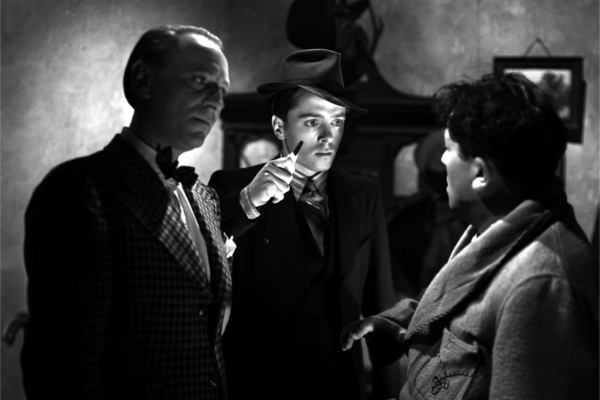
Brighton Rock
With its formulaic insistence on love interest, classic Hollywood rarely produced a movie built
around such a lonely, isolated hero as Pierre,
or as the pious, misogynistic Pinkie (Richard Attenborough) in Brighton Rock (1947), the Boulting
Brothers’ adaptation of Grahame Greene’s novel. The movie does not quite plumb
the caustic depths of Greene’s sin-obsessed Catholic vision, but with help from
the spooky, baby-faced Attenborough it tells a daringly unpleasant story, centering
on Pinkie’s cruel deception of the pitifully naïve Rose, a waitress whom he
marries to give himself an alibi for a murder. The surging crowds of seaside
holiday-makers serve to highlight Pinkie’s clammy, joyless solitude, and the
cheaply festive atmosphere of Brighton
provides a fitting backdrop for the shabby, pointless vindictiveness of his
gang.
The alienated, violent loner is a staple of modern nightmares all over the
world, from the razor-wielding Pinkie to the “stray dog” thief Toshiro Mifune
pursues through the seething Tokyo
underbelly, to the title character of The
Hitch-Hiker (1953), who haunts desolate roads in the Mexican desert and
preys on travelers who give him rides. This raw, pitiless masterpiece directed
by Ida Lupino was based on the real case of a serial killer named William Cook,
a misanthropic loner who accounted for his 1950 crime spree by stating, “I hate
everybody’s guts and everybody hates mine.” Lupino’s film focuses on the
triangle of the killer (terrifyingly played by William Talman) and two
middle-aged fishing buddies (Frank Lovejoy and Edmond O’Brien) whom he takes
captive, it seems primarily for the sadistic pleasure of exerting power over
them. Isolated in a harsh, prehistoric landscape, the civilized men are
confronted by brute power in its most primitive form. They are stripped of their
independence and their pride, mocked for their weakness by a man who views crime
as the ultimate form of self-reliance. This tale of a road-trip vacation
turning into a savage ordeal in the wilderness makes a perfect American entry
into a noir world tour.
In American noir, the Mexican border is imagined as an escape hatch. People
with the law on their heels dream of making it to South America where they can
live in peace, where no one will bother them, where the endless chase after
money and flight from enemies will be over and they can sit under a palm tree
and watch the ocean. It’s nothing but a mirage, of course; if they do make it
across the border, they find themselves in a deadly fun-house, a delirious
world where no rules apply. But what do things look like from the other side of
the looking-glass? Noir City 12 will offer a sampling of rare Mexican and
Argentine noir from the 1950s, films little known and never screened in this country,
but bearing all the hallmarks of classic noir. My own anticipation has been
heightened by the little I’ve been able to see online (in un-subtitled prints)
of Never Open That Door (Carlos Hugo
Christensen, 1952), an Argentine adaptation of two Cornell Woolrich stories, with
Woolrichian dread saturating every inky-shadowed interior and fear-stricken
close-up; In the Palm of Your Hand (Roberto
Gavaldón, 1951), an elegant Mexican thriller that belongs to the fascinating
sub-genre of noir about fortune-tellers and mind-readers (The Amazing Mr. X, Night Has a Thousand Eyes), suave charlatans
with smoke-filled crystal balls who prey on weak minds; Victims of Sin (Emilio Fernandez, 1951), an electrifying low-life
saga of flashy pachuco gangsters and
sexy dancers, set in nightclubs that throb with Afro-Cuban rhythms; and The Black Vampire (Roman Vinoly Barreto,
1953), an adaptation of M with the
child-killer—the ultimate deadly loner and exile from human society—stalking
little girls down dark, empty streets, salving his tortured impulses by
crushing a glass in his hand and stroking his bloody fingers.
II. Living in Ruins: Postwar Cities
World War II runs under the surface of American noir, in damaged psyches and
dark secrets, but Hollywood
generally shied away from the war’s true horrors. It was left to other
countries to show what it was like to live in the wreckage of bombed cities,
what it was like to be on the losing side. In the aftermath of firebombing and
nuclear devastation, humiliating defeat and occupation, Japanese cinema
flourished with a new vitality and maturity, skeptically examining the nation’s
history, culture, and current predicament. (Joan Mellen has called cinema “Japan’s great
dissident art form.”) In the postwar years traditional cultural values and
obligations retained their hold, but many questioned feudal ideals of loyalty,
duty and self-sacrifice. American influence promised new freedoms, but was
blamed for encouraging selfish, crass behavior.
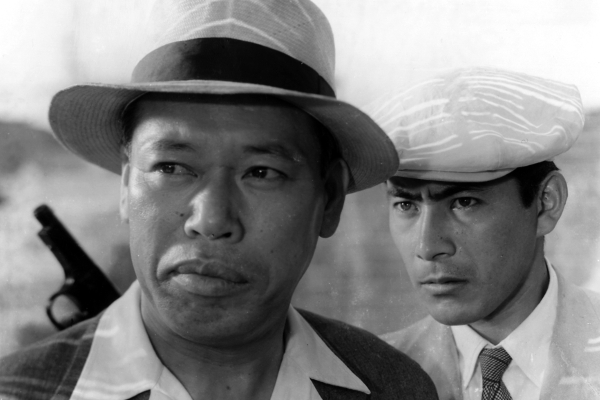
Stray Dog
Akira Kurosawa tackled these conflicts head-on in his early films with
contemporary settings. In Drunken Angel (1948), postwar nihilism is personified by a flashy, feral gangster played by
Toshiro Mifune, the actor whose searing energy and visceral, kinetic style
embodied Kurosawa’s cinematic style. The film focuses on a scruffy but humane
doctor (Takashi Shimura) who tries to save the young yakuza from dying of tuberculosis. The sickness, which seems to
waft from a scummy, pestilent pond at the heart of a poor neighborhood, plainly
symbolizes the ills of Japanese society. In the stronger and more gripping Stray Dog (1949), it is a heat wave that
makes palpable the chaos and confusion of postwar Japan. Here the startlingly
handsome young Mifune plays Murakami, a zealously conscientious rookie cop desperate
to recover his gun after it is stolen on a crowded bus. Yusa, the thief, is
overtly depicted as his doppelganger; they are both veterans of the defeated
army, members of what an older cop (Shimura) calls—with some pronunciation
difficulties—the “après-guerre” generation. Murakami becomes frantic with guilt
as his stolen gun is used in robberies and killings, as though he were
responsible not merely through his carelessness, but in some more personal way.
The pairing of Murakami and Yusa may be schematic—the thief “blames the war for
all his problems,” while the cop has overcome his bitterness and dedicated
himself to society—but the film’s real strength lies in its evocation of the
world they both inhabit. To find his gun, Murakami haunts the back alleys
posing as a vagrant in search of a weapon. In a long, mesmerizing, wordless
sequence, he moves through a kaleidoscope of flickering sun and dusty haze,
pushing through sweaty crowds around shabby food stalls and bars, passing
tableaux of lounging derelicts. The camera is restless and jumpy, images dart
and blur into each other like wary glances. The war’s effects are not
visible—we don’t see any ruins—but they are felt everywhere, in the confused
mixture of western and Japanese styles, in the mood of exhausted tension, of
lurking shame and anger building, finally, to a wail of anguish.
The ruins of great world capitals like London,
Vienna, and Berlin provided
backdrops for films that picked through the moral landscapes of countries
devastated by war. (Marc Svetov has used the term “rubble noir” for this
sub-genre.) The archetypal rubble noir is The
Murderers are Among Us (1946), the first feature film produced in Germany after
the war. The terrible beauty and morbid fascination of Berlin’s ruins fill every frame: people walk
down the middle of streets that look like glacial moraines, lined with delicate
spires and chimneys of bricks, shrouds and slivers of buildings forming a
skeleton city. People live in shells of apartments with shattered windows, and
drink in basement cabarets where girls dance for empty tables. Director
Wolfgang Staudte’s use of shadows, with whole scenes playing out in silhouette
(harking directly back to Warning Shadows and other expressionist classics) is fitting: the style that the Nazis swept
away as degenerate comes back to portray the world the Nazis left. Perhaps not
surprisingly given its status, the film is didactic, more a statement than a
story. It follows a young woman (Hildegarde Knef) whose innocence and hope have
survived a concentration camp, and a doctor (Ernst Wilhelm Bochert) haunted by wartime
crimes in which he was complicit. But while the script may seem a bit pat, it
expresses an urgent desire for redemption that is as much a raw fact of postwar
German experience as rats and rubble.
The British by contrast could take pride in their “finest hour,” but the decade
following the war was not a time of triumphant prosperity in Britain; it was
an age of austerity, beset by rationing and shortages, by a sense of loss and
uncertainty in the face of radical social and political changes. The threadbare
texture of postwar English life is palpable in Robert Hamer’s It Always Rains on Sunday (1947), a
day-in-the-life portrait of working-class Bethnal Green. Backyard bomb-shelters
are now storage sheds; cold drafts are patched with leftover blackout fabric. Families
bicker over breakfasts of haddock; wooden-faced bobbies patrol noisy street
markets; slovenly landladies tipple from gin bottles; middle-aged shopkeepers
dally sheepishly with teenage girls; whiny small-time hoods drink mugs of tea
at outdoor stalls in the pre-dawn rain. This too is a world confusedly torn
between selfish desires and ambitions and the traditional values of duty and
sacrifice, repression and politeness epitomized by Brief Encounter (1947).
The imperious Googie Withers plays Rose, a former barmaid who married a dim
older man for security. She personifies a distinctively British mode of being:
sharp and irritable, yet resigned to making the best of things, her mute
yearning for a lost past stifled behind a stiff-lipped mask. Then her former
lover (Withers’ real-life husband John McCallum) breaks out of prison and turns
up on her doorstep, and her efforts to hide him ratchet up the tension of her
unsatisfying life to nerve-shredding levels. Suspense heightens but never
displaces an attentiveness to the mundane reality of working-class lives that
was extremely rare in Hollywood films of the
time.
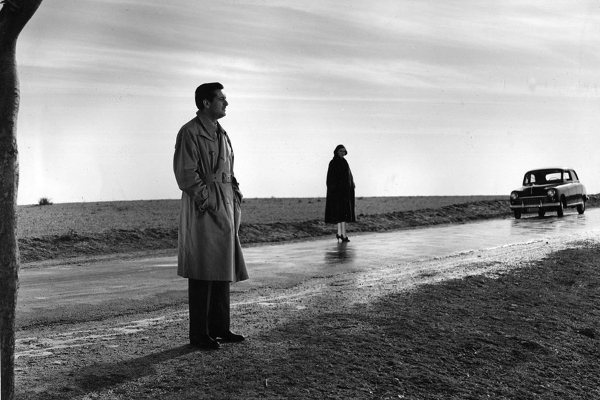
Death of a Cyclist
Death of a Cyclist (Juan Antonio
Bardem, 1955) is another film in which an adulterous love shines an unforgiving
light on the lovers’ world. A man and woman run over a cyclist and leave him to
die because they don’t want their affair exposed; the fear and suspicions
spawned by this crime reveal the selfishness and corruption of the wealthy
elite in Franco’s Spain.
There is a pointed scene in which the man, Juan, goes to visit the squalid,
bustling tenement where the dead cyclist, a factory worker, lived. An assistant
professor who seems to sleepwalk through his life, Juan was once a man of
political convictions. He has both been hollowed out by wartime experience and
weakened by his love for a beautiful but utterly self-absorbed woman; his moral
sense is re-awoken, ironically, by student riots directed against him. Like
many American films of the time, Death of
a Cyclist folds its criticisms of society into a classic plot of guilt and
suspense. The film’s wide-open, vacant spaces, starting with the stark,
windswept road where the accident occurs, give a feeling that there’s nowhere
to hide. The abrupt shock cuts that continually jerk the viewer from one scene
to the next add the sense that the characters are not in control, and have no
idea what’s coming next. But attributing the characters’ behavior to the
society they live in or the history they’ve lived through is too easy; as Juan
tells his lover: “The war is very
convenient. You can blame everything on it.”
Unlike London
or Berlin, Paris was never bombed;
it suffered not physical damage but invisible corruption of social bonds during
the Occupation, which bred betrayals and reprisals, resentments and compromises
and lies. Quai des Orfèvres (Jenny Lamour, 1947) uses the tools of the police procedural to excavate a
grubby corner of the city, where the cheerful vulgarity of the music hall
shades into a creepy realm of lecherous old men and pornographic photo shops.
This is not the city of light, but a dark and grimy metropolis filled with
people nursing perverse and unrequited passions. Nonetheless, Quai des Orfèvres has glints of human warmth
lacking from many of Henri-Georges Clouzot’s brilliant but nasty and
misanthropic films. Louis Jouvet smuggles it in with his performance as the
shabby yet astute and secretly tender-hearted detective.
France is represented by more films in the Noir City
lineup than any other country outside the United States, a tribute deserved
by the nation that named film noir. One of them was made by an American (Jules
Dassin’s Rififi [1955]), and two are
about Frenchmen abroad, Jean-Pierre Melville’s Two Men in Manhattan (1959) and Clouzot’s Wages of Fear (1953). The midcentury world was one of fraying
borders, growing migration, and spreading monoculture that left people feeling,
in Edward Dimendberg’s phrase, “in exile at home.”
The festival will open with the crown jewel of multi-national noir, The Third Man (1949), a joint production
of the American David O. Selznick and the British Alexander Korda, set in occupied
Vienna, with a
cast of American, British, Italian, and Austrian actors. Written by Graham
Greene and directed by Carol Reed, one of cinema’s greatest urban poets, The Third Man possesses intoxicating style and at the same time dissects
the ease with which style can trump substance in the movies—the way, in film
noir especially, glamour and aesthetic bliss can set one’s moral compass
spinning. In the film’s tilting, labyrinthine world, beauty and corruption,
cruelty and charm blend as smoothly as coffee and cream. It’s a world of
splendor and rubble, leprous baroque apartments in half-gutted buildings, bleak
fairgrounds and tired gypsy cafes. Anton Karas’s famous zither score, jaunty
and wistful, imbues a mood of wry detachment and haunting nostalgia.
Holly Martins (Joseph Cotten), a naïve writer of western novels, arrives in bombed-out
Vienna to meet an
old friend, and winds up stripped of his illusions and hopes, equally wounded
by the seductive cynicism of Harry Lime (Orson Welles) and the impatient moral rigor
of Major Calloway (Trevor Howard). Under the charismatic mystery of Welles’s
antihero lies an abyss of nihilism: he believes “the dead are happier dead.”
Lime is an opportunistic scavenger in Europe’s
urban ruins, defending his amorality by comparing himself with governments that
view their own citizens the way he views the children whose lives he translates
into cash. Looking down from the top of a Ferris wheel at these impersonal
“dots,” he might be a bombardier calmly surveying his targets.
Holly earns no respect, even from himself, by siding with Major Calloway, whose
cynicism is the flip side of Lime’s: “death’s at the bottom of everything,” he
shrugs, and “the world doesn’t make any heroes.” But it is Anna (Alida Valli), Lime’s
former lover and one of Europe’s “displaced
persons,” who drives the final stake through Holly’s American optimism. In a
shot that seems to last forever, the woman without a country or a future walks
up a long, straight avenue of pollarded trees. Finally she passes out of sight,
leaving Holly stranded in the wintry sun and graveyard quiet, “deprived of the
memory of a lost home or the hope of a promised land.”
![]()
LATEST ARTICLES
-20140814-173707-thumb3.jpg)
Fighting Words
by Imogen Sara Smith
posted August 12, 2014

Fighting Words, Part 2
by Imogen Sara Smith
posted August 20, 2014

On the Margins: The Fil…
by Andrew Chan
posted August 12, 2014

Robin Williams: A Sense…
by David Schwartz
posted August 12, 2014
 World Weary
World Weary
THE AUTHOR
Imogen Sara Smith is a writer living in Brooklyn. She is the author of two books, In Lonely Places: Film Noir Beyond the City and Buster Keaton: the Persistence of Comedy
More articles by Imogen Sara Smith
